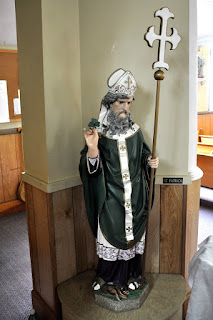The War of Spanish Succession was settled in 1713 with the Treaty of Utrecht. Across the Atlantic, this Treaty provided Britain control of mainland Nova Scotia and France control of the lle Royale, today known as Cape Breton Island. On the Eastern shores of this island the French would develop an important, ice free port as well as a rich cod fishing industry. The eastern port city would be named Louisbourg, in honor of King Louis XIV. Over 30 years time, the town and garrison would be surrounded by 2.5 miles of walls. The fortress of Louisbourg at one time was a city where over 4,000 people lived. During its peak, it was the third busiest port in North America and was considered France's prize possession in the New World. But Louisbourg would fall twice, first to New England troops in 1745. After three years under British rule, the Fortress was returned to France under treaty. The fortress would be defeated a second time, to the British, in 1758. Following the fall of Quebec, Louisbourg would be blown up in 1760. The stones from the fortress would be used in the constructions of buildings in both Sydney, Nova Scotia and also Halifax, Nova Scotia. These stones would also be used in the construction off the Anglican Church of St. George (1785) (picture below) in Sydney, Nova Scotia.
In 1961, the Canada Parks would embark upon the largest reconstruction effort in North America, spanning over 20 years, rebuilding the fortress (1/4 of it) on the original foundations with thousands of historical documents to work with. What they have accomplished is impressive, and the tour of the facilities were a full day with so much to see. The French provided so much beautiful architecture in their fortress. This was an unexpected joy and so worth visiting. While here we also met up with 4 other couples we met while hiking in Cape Breton....it really is a small world.
We are enjoying the history and the landscape. This is an unusually cold summer here; we as well as many others are still waiting for summer to arrive. We keep hearing it is coming (they sure hope as their winter was massive). Days so far, if we make it into the 60's we celebrate. We are hearing maybe 70's next week.
In 1961, the Canada Parks would embark upon the largest reconstruction effort in North America, spanning over 20 years, rebuilding the fortress (1/4 of it) on the original foundations with thousands of historical documents to work with. What they have accomplished is impressive, and the tour of the facilities were a full day with so much to see. The French provided so much beautiful architecture in their fortress. This was an unexpected joy and so worth visiting. While here we also met up with 4 other couples we met while hiking in Cape Breton....it really is a small world.
We are enjoying the history and the landscape. This is an unusually cold summer here; we as well as many others are still waiting for summer to arrive. We keep hearing it is coming (they sure hope as their winter was massive). Days so far, if we make it into the 60's we celebrate. We are hearing maybe 70's next week.
Dauphin Gate Look Closely at this Gate After the gate doors are closed, as the draw bridge on the far side is drawn up, the overhead red beams come down in front of the gate doors to provide stronger protection Fortress of Louisbourg King's Bastion Fortress of Louisbourg King's Bastion Dignitary Dining Room Fortress of Louisbourg Governor's Bedroom Fortress of Louisbourg Military Chapel Fortress of Louisbourg Mary Statute in Military Chapel Fortress of Louisbourg Basin Fortress of Louisbourg Basin Fortress of Louisbourg Basin Fortress of Louisbourg Storeroom Fortress of Louisbourg Iron Collar Fortress of Louisbourg Village Street Fortress of Louisbourg Frederic Gate Passage from the Sea Fortress of Louisbourg Fisherman's Cottage Outside the Gates If the Fortress was attacked they were ordered to set their homes on fire and join the defending of the Fortress. Fortress of Louisbourg Model off the Entire Fortress Fortress of Louisbourg When is mom bringing Dinner! Fortress of Louisbourg |
































































